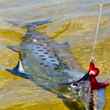The 9’5wt Orvis Clearwater deserves an article’s worth of accolades, but if nothing else this rod proves a surprising truth:
Orvis has, for the moment, lept to the front of the pack in the arms race that is manufacturing fly fishing tackle. Top to bottom, Orvis’ offerings outdo or match even the fiercest competition, and the updated Orvis Clearwater is perhaps the best example of this resurgence.
The rod retails for $198; if you get the Clearwater reel and line with it, you’re looking at $311 for an outfit that’s ready-to-fish straight out of the box. It’s a fantastic all-around rod, but really excels in that 25-50 foot casting range. Of course, at its price range, it’s not built in the US. The Clearwater does, however, come with the standard Orvis 25-year guarantee.
But what specifically makes the Clearwater such a standout piece of gear? Let’s look.
What Works
All-around performance
Fly rods are tools. The top-of-the-line Orvis, Sage, Winston, Thomas & Thomas, and Scott rods are the Milwaukee or DeWalt of fly fishing, while picking up an entry-level rod is akin to taking the Harbor Freight gamble. Often, a Harbor Freight special gets the job done, but not as well – or as enjoyably – as something more expensive. Rarely, though, you’ll luck into one hell of a great tool.
The 9’5wt Clearwater outfit is that tool. You’ll never mistake it for a Milwaukee or DeWalt, but it comes closer than anything else the industry offers. The Clearwater isn’t terribly light, but it feels good in the hand. It’s a medium-fast rod that’s more crisp than relaxed, with a forgiving action new and novice casters will appreciate. The tip is softer than I expected, and does an admirable job in tippet protection. A buddy and I took turns fishing some size 14 parachute BWOs on 6x tippet in a snowstorm, and the tippet never broke on either of us.
Delicate-enough presentation
Orvis sends the Clearwater outfit with a matching Clearwater II reel and WF line. The reel is phenomenal, but I do appreciate that Orvis didn’t overweight the line too much. That allows the rod to load well at medium distances, but still maintain enough delicacy to lay down smaller dries to wary trout.
Now, don’t mistake the Clearwater as a specialist dry-fly rod. It’s not. But it handles smaller flies just delicately enough to make those moments of finesse possible.
Build Quality
Bear in mind this is all relative since the Clearwater is a $198 rod, but its build quality is impressive. Orvis opted to give it an H3-themed sticker above the cork, alongside dark gray thread wraps holding chrome snake guides in place. The cork isn’t top-drawer stuff by any means, but it’s better than what I’ve seen on most budget-friendly rods of late.
The black chrome blank is nice, looks great in the sun, and so far doesn’t seem to absorb scratches like the finish on other entry-level rods.

Clearwater II Reel
I’m not sure if I’m more impressed with the Clearwater rod or reel. Orvis packs a Rulon disc drag into a die-cast large-arbor affair that’s damn near bombproof. The reel has surprisingly smooth pickup, easily adjusts mid-fight, and is above and beyond the value I’d expect from a combo kit reel.
What Doesn’t Work
In-close performance
The Clearwater does just about everything well, but it’s not a great rod for fishing inside of 25 feet. The rod is stiff enough that it really needs at least 25 feet of line out to properly load it. That’s the tradeoff made, though, for stellar performance at other distances, while keeping the rod in I-don’t-have-to-hide-this-purchase-from-my-significant-other territory.
Full wells grip
The cork grip on the Clearwater is a slightly modified version of a standard full wells. It’s normally a grip style I like, and it’s one most production rods seem to be gravitating towards of late. It feels a bit overkill, though, on the Clearwater. This is a standard do-it-all 5wt, make no mistake – but it’s no H3. A reverse full wells grip would suit the rod much better and increase the connection between the angler and the rod.
No hook keep
This is my only knock against the H3 line of rods, and when the Recon gets its update as the Clearwater did, I assume this feature will disappear as well. Tom Rosenbauer, marketing director and fly fishing guru for Orvis, told me he thinks hook keeps are “archaic.”
I personally like them, and it drives me nuts when I reach for the hook keep and it’s not there. Rosenbauer says anglers are split fairly evenly on wanting a hook keep on their trout rods, which is why Orvis opted to remove it from the H3 and the updated Clearwater. I’m not sure if adding one on your own voids the warranty, though I suppose that’s always an option.
Final Word
The 9’5wt Clearwater outfit is hands-down the best entry-level, bargain-buy fly rod on the market. I didn’t think I’d find a $200 rod that I liked better than the Fenwick Aetos, but Orvis put together another fantastic product here. It’s a fast enough rod that novice casters will like it, but the Clearwater has a soft tip to protect lighter tippet. It handles dry flies well, throws streamers just fine, and does its job as a nymph stick. The build quality is better than what I’d expect on an entry-level rod.
Even with the cork grip, lack of a hook keep, and its less-than-stellar performance in close, the Clearwater is a clear winner in the entry-level rod market. Add the stellar Clearwater II reel and line, and I don’t see a better outfit available for less than $350. The Clearwater is a fun, affordable, blue-collar fly rod that has its place in the quiver of new and old anglers alike.






























Comments
Howard Hayden replied on Permalink
I have three of the Clearwater rods. They are nice and work well. I use the Battenkill reels and I do like hook-keepers but I am archaic...like Edward Ringwood Hewitt and Sparse Grey Hackle and Roy Ovington and Ray Bergman of TROUT. As a skinny child who struggled with heavy Phillipson cane rods, I learned from Enos Bradner and Ken and George McLeod, of Stillaguamish fame when there were fish in the river...but not know. Ted Trueblood and I wrote letters to each other. Then it came to pass that I fished longer hours for fewer and smaller trout. Then there were none left in our iconic rivers and I moved to creeks for small trout, barbless hooks with high-viz flies that I could see. Then I have become old and mobility is challenging. I cannot take 22 hour flights to Patagonia because of risk of blood clots on long flights...and significant expense aunque hablo el hermoso y melodioso idioma castellano y los guías de pesca allí me son pacientes y han llegado a ser mis amigos de pluma, pues, de escritos electrónicos. According to the 90th Psalm, I should have died a few years ago, but my mother used to say: ''you will be late to your own funeral service!¨ Thanks for reading. I love the 6 ft., 1 wt. Clearwater for the tiny streams and pretty, little trout with parr marks. Thanks for reading. Leland is a fine gentleman and knows me over many years.
Pages